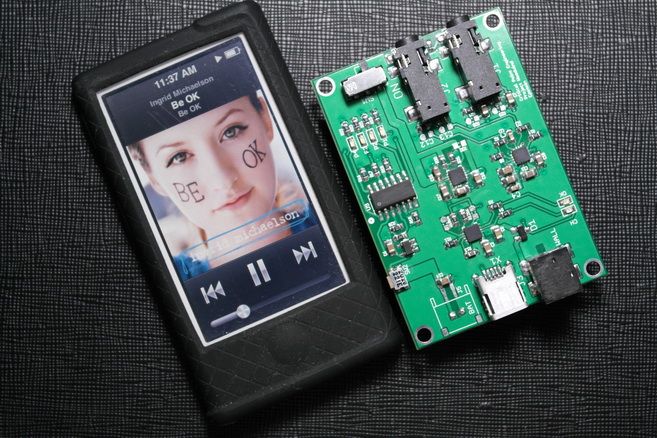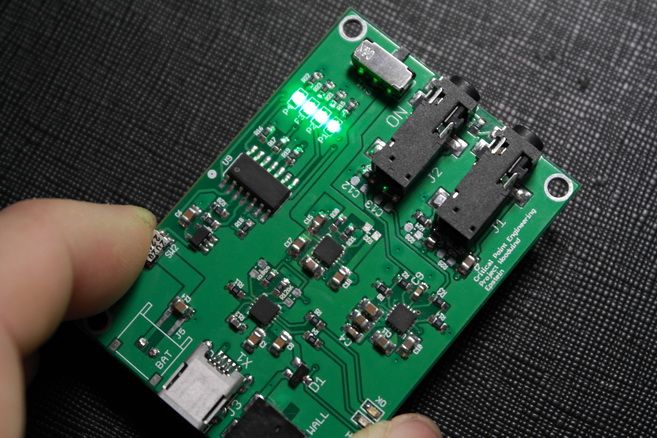
Project Woodwind prototype, next to Nano 7G.
Spec
Frequency Response: 20Hz – 20kHz +/- 0.15dB
Output Power: 120mW @ 32 ohm
SNR: -109.2dB (A weighted)
Gain: 6dB fixed
THD+N: 0.002%
The spec above is basically measurement from an Audio Precision with a 32ohm load. Though it is done by its creator, my later much less accurate RMAA measurement does confirm (or more precisely, not overturning) the result. The output impedance is measured to be 0.15ohm. On my own fixed 47ohm dummy load, it can pump out nearly 70% of power of O2. All and all, it looks quite impressive for a match box sized PCB with a rather simple topology.

The LED battery indicator.
One of the really cool features on the amp is the battery indicator. It is a row of four LED that shows the amount of battery left with a push of a button on the side. All four LED light up mean a full battery, and three LED means 75% and so on. The one indicator that is missing from the prototype is a LED for power. The amp is turned on / off with a switch, but without an LED indicator, one might forget to switch it off. However, it will be added to the final version, along with some minor tweak to 3.5mm socket position so it can accommodate larger plug. The Li-ion battery on the amp is 850mAH and said to last over 18 hours in a full charge. However, I didn’t perform a drain test to confirm though it did last quite some time in normal use. Another thing that is missing is a volume knob. The amp is designed as an inline amp (*double amping) for headphone-out for a fixed 6dB gain so volume control has to be done on the source. A good thing is that the amp is transparent and noise-free enough that double amping should have no adverse effect to SQ.
Now comes the important part – the SQ. Measurement wise, Project Woodwind looks close to ideal. The gain might not be enough for some of the higher impedance full size, but as an inline amp intended for portability, the listed spec should be more than enough for typical headphone to low impedance custom IEM. However, good looking spec only goes as far as the actual sound of the amp – on the matter, the amp really does excel my expectation. Up till this point, the best sounding ultraportable amp I have listened is the iBasso T5 with its BTL grounding. But now, it is the Project Woodwind. As far as my impression goes, it is a sound that closely resembles the O2 – detail, clean, tight and very transparent. The only noticeable area that isn’t as good is the soundstage - not quite as layered and deep, but still really good on its own. In fact, I think I’ll easily rank Project Woodwind about on par with JDS labs C421, just under O2 and above T5. Again, very impression for a match box sized amp.
Until the final production is out, I think it is still too early to say how other aspects of the amp will measure up, especially EMI. But so far, I have nothing bad to say about Project Woodwind purely as an inline amp. But If it can accommodate a volume control, gain switch or perhaps even a bass boost without compromising the SQ or the size, I’ll think we could very well have a huge winner here. For those of you who are interested in picking an ultraportable amp in near future, this is the one you really want to keep an eye on.





